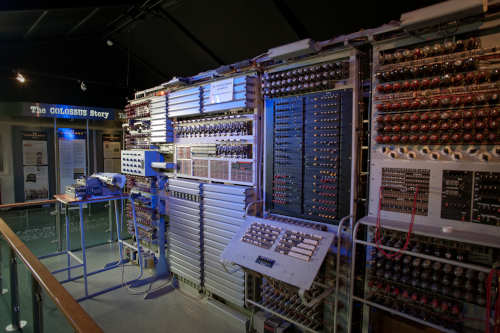Communications of the ACM
Turing, Churchill, and the Colossus

Did Turing collaborate on the Colossus?
The computer science historian Brian Randell, who inquired with firsthand witnesses in regard to Turing's collaboration on the Colossus, states:
"Apparently he [Turing] did not have any direct involvement in, or influence on, the design or use of Colossus [...]. His visits to Dollis Hill occurred prior to the start of the Colossus work, and Newman does not remember his presence at any of the meetings that Newman and Flowers held at Bletchley Park, Turing's prewar work on computability was well known, and virtually all of the people I have interviewed recollect wartime discussions of his idea of a universal automaton [...]. Good has written that "Newman was perhaps inspired by his knowledge of Turing's 1936 paper". However, Newman's view now is that although he and his people all knew that the planned Colossus was theoretically related to a Turing machine, they were not conscious of their work having any dependence on either these ideas or those of Babbage" (see Brian Randell: The colossus, in: Nicholas Constantine Metropolis; Jack Howlett; Gian-Carlo Rota (editors): A history of computing in the twentieth century, Academic press, New York, London etc. 1980, page 78).
Did Churchill command the destruction of all Colossus computers?
For decades it was said that Prime Minister Winston Churchill commanded the destruction all Colossus (see Fig. 1) machines immediately after the end of the war. This rumor is evidently false, as Tony Sale, the builder of the reconstructed cryptographic machine, explains:
"Eight of the ten Colossi were dismantled in Bletchley Park. Two went to Eastcote in North London and then to GCHQ (Government Communications Headquarters) at Cheltenham. These last two were dismantled in about 1960, and in 1960 all the drawings of Colossus were burnt, and its very existence was kept secret" (see Anthony Sale: The Colossus computer 1943–1996 and how it helped to break the German Lorenz cipher in WWII, M & M Baldwin, Cleobury Mortimer, Shropshire 2011, pages 11–12).
Components of the machines dismantled in Bletchley Park were ostensibly brought to the University of Manchester through the intercession of Max Newman.
We have primarily Brian Randell to thank that we now know far more about the happenings in Bletchley Park. He requested the release of documents and conducted numerous discussions with former firsthand witnesses.

Fig. 1: The Colossus (reconstruction). As with the Turing-Welchman Bombe, the Colossus is also functional and is regularly demonstrated in Bletchley Park.
The computer, which remained top secret for many years, is plug-programmed. Credit: The National Museum of Computing, Bletchley Park
References
Bruderer, Herbert: Milestones in Analog and Digital Computing, Springer Nature Switzerland AG, Cham, 3rd edition 2020, 2 volumes, 2113 pages, 715 illustrations, 151 tables, translated from the German by John McMinn, https://www.springer.com/de/book/9783030409739
Metropolis, Nicholas Constantine; Howlett, Jack; Rota, Gian-Carlo (editors): A history of computing in the twentieth century, Academic press, New York, London etc. 1980, xix, 659 pages
Sale, Anthony: The Colossus computer 1943–1996 and how it helped to break the German Lorenz cipher in WWII, M & M Baldwin, Cleobury Mortimer, Shropshire 2011, 18 pages
Herbert Bruderer ([email protected]; [email protected]) is a retired lecturer in the Department of Computer Science at ETH Zurich and a historian of technology.
No entries found